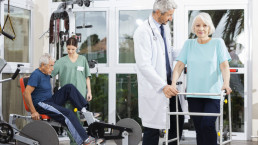
Occupational Therapy for Senior Citizens: What It Looks Like and How It Can Help You
According to the American Occupational Therapy Association (AOTA), the general scope of Occupational Therapy (OT) is defined as follows:
“Occupational therapy is the only profession that helps people across the lifespan to do the things they want and need to do through the therapeutic use of daily activities (occupations). Occupational therapy practitioners enable people of all ages to live life to its fullest by helping them promote health, and prevent—or live better with—injury, illness, or disability.”
Let’s take a step back and review what this means for the senior population.
Older adults receive OT in a variety of settings including outpatient clinics, home health agencies, hospital (intensive care, inpatient), skilled nursing facilities, assisted living facilities, community-based settings, and specialty private practices.
In each setting, OT provides certain interventions according to the patient’s goals as well as to what they can ethically/legally bill for per facility.
The following are just a few examples of what OT addresses when it comes to senior care:
Activities of Daily Living (ADLs): This includes basic tasks that the senior individual wants to or needs to complete: showering, dressing, toileting, mobility, self-feeding, and hygiene completion.
OT’s goal would be not to complete the tasks for the person, but to restore the person’s capabilities of independently completing the tasks themselves.
Instrumental activities of Daily Living (IADLs):
Areas include financial management, medication management, community activities, driving, spiritual or religious participation, cooking, meal preparation, and household cleaning tasks.
Believe it or not, many OTs working in a skilled nursing, transitional unit, or inpatient setting will address these complex tasks if the patient finds it necessary before discharging safely home.
Fall prevention and recovery:
Some OTs are trained in carrying out fall prevention and fall recovery programs, which is very relevant to senior needs since falls and inability to recover from falls frequently occurs with this population.
Adaptive Equipment:
OTs are the go-to clinicians for explaining how to use unrecognizable medical equipment including: reachers, shoe horns, sock aids, shower chairs, toilet risers, long-handled sponges, wide-handled spoons, plate guards, and the list goes on.
OTs will introduce adaptive equipment when functionally necessary and instruct the patient and/or caregivers how to safely use it to fulfill their daily living tasks.
Family/Caregiver education:
Education regarding exercise programs, orthotic programs, adaptive equipment, and safety in the home comes in handy when patients are getting ready to discharge home.
Instead of leaving caregivers in an uncomfortable and unfamiliar situation, OT helps fill the gaps by providing information and resources about how to transition care into the home environment.
Orthotics:
Some post-surgical or post-traumatic conditions require acute or long-term bracing or splinting to promote joint and muscle healing.
Examples include post-stroke deficits such as shoulder subluxation, hypertonicity or muscle atrophy through an upper extremity, etc. Others could be slings or braces for post-surgical shoulder conditions.
OT could address several items: assessment and fitting for a brace/splint, implementation of a wear schedule, program development for maintenance and cleaning, and program development for a wear schedule to be carried out at home by others if necessary.
Manual Therapy techniques:
“Manual” includes any hands-on techniques that promote healthy joint movement and circulation to tissue.
Patients who may benefit from manual therapy are those who have trouble voluntarily moving a limb due to pain, lack of movement, or lack of sensation.
Therapeutic exercise:
OT provides exercise regimens that are relevant to the patient’s functional goals.
For example, if a patient wishes to transfer independently from their wheelchair to a toilet seat but lacks the upper body strength to pull up on the grab bar, then OT would create an upper body exercise program to address the weaker muscle groups.
Physical Modality Agents (PAMs):
This includes complex machinery including E-stimulation units, ultrasound units, heating pads, paraffin baths, contrast baths, cryotherapy tools, or any agent used for pain management and promotion of functional movement.
OT usually supplements a PAM with other interventions including ADLs/IADLs, manual therapy, or therapeutic exercise.
Sources:
https://www.aota.org/Conference-Events/OTMonth/what-is-OT.aspx
Subscribe for Alerts about New Availability in Your Area
Newsletter